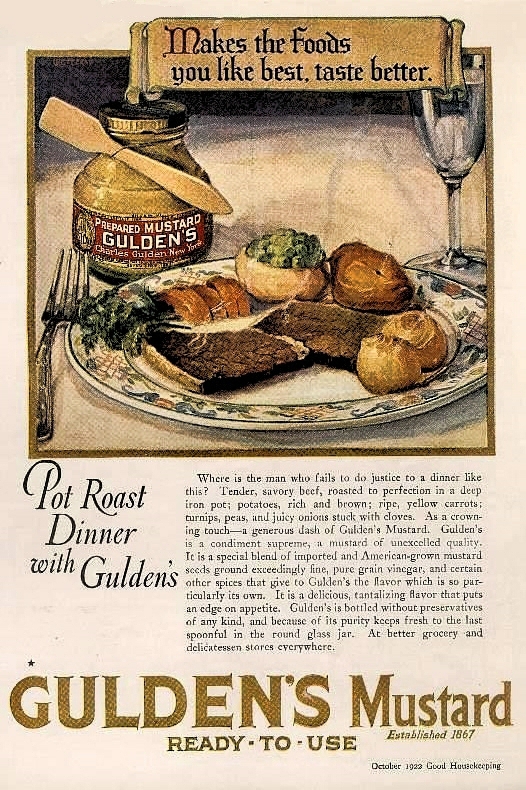
Thursday, December 30, 2004
Page 15
REMINISCING (Column)
Gulden’s Is Oldest Nationally Sold Prepared Mustard—Not French’s
By ROGER M. GRACE
The answer is: “Gulden’s.”
The question, posited here last week, is: what mustard, still in existence and marketed nationally, was the first to be sold in the U.S. in prepared form?
Falsely laying claim to that distinction is the UK conglomerate that makes French’s Mustard. It does so through a New Jersey public relations firm that claims various distinctions for the product, unbridled by truth.
French’s Mustard was introduced at the 1904 World’s Fair in St. Louis, in prepared form—that is, the mustard powder, or “flour,” had already been mixed with liquid and combined with spices, and was ready to use. As I pointed out last week, there were newspapers published well before 1904 which bore advertisements for prepared mustard.
Rival manufacturers have not spoken out about French’s false claims. However, Gulden’s, as well as Heinz, have quietly mentioned, through the years, the beginnings of their own products in the 19th Century.
The website of ConAgra, the conglomerate that now owns the Gulden’s brand, says this:
“Gulden’s traces its beginnings to 1862 when it was founded by Charles Gulden in his Elizabeth Street quarters near the South Street Seaport in downtown New York. For it was here that Charles could obtain the mustard seeds, rare spices and vintage vinegars used for the truly unique flavor of Gulden’s Spicy Brown Mustard. The classic Gulden’s mustard recipe has stayed a well-kept secret for over 138 years.”
(Presumably the information was posted four years ago.)
“Gulden’s Spicy Brown Mustard” is the current name of the product. It wasn’t called that when Charles Gulden made it. Glass jars containing the mustard simply said:
“CHAS GULDEN”
“NEW YORK”
Vintage Gulden Mustard jars are traded on the Internet, most identified as being from the 1880s. An article on old bottles appearing on the University of Massachusetts website says of a Gulden’s Mustard container: “We can date this bottle very accurately because the manufacture suggests that it is pre-1880 (the entire neck is applied, no seam)….”
While it is known that Charles Gulden produced ready-to-use mustard well before R.T. French’s sons did, there is some doubt as to just when he got started. Although the date set by ConAgra is 1862, labels on Gulden Mustard jars in the 1910s and 1920s said, “Established 1867.”
|
|
Sales were apparently restricted to New York for a number of years. The April 13, 1905 trademark application for “Gulden’s Mustard” showed 1875 as the date when the words were first used in interstate commerce.
Charles Gulden and his kin gained various patents on containers for mustard, as well as bottles for other foods including the Guldens’ secondary product, olives.
On March 16, 1875, Jacob Gulden, Charles Gulden’s father, obtained a patent on a mustard bottle, shaped somewhat as the glass French’s ones are today. And on July 5, 1881, he was awarded a patent on a “vessel for holding and dispensing mustard” featuring a plunger—still in use on large, commercial bottles of mustard.
|
|
Charles Gulden on Jan. 30, 1893 secured a patent on a mustard jar cap, and on March 16, 1897, Charles Gulden Jr. was granted a patent on an improvement upon his father’s device.
Gulden’s “spicy brown mustard” isn’t brown, these days. It’s a darker shade of yellow than French’s, Heinz or Morehouse mustards, but it, like they, is “yellowized” with turmeric.
The American public has cottoned to yellow as the color for mustard.
Realizing this, Gulden’s began marketing Gulden’s Prepared Yellow Mustard in 1949, and registered it as a trademark in 1951.
This was not the first time Gulden’s tried to cash in on French’s success with its yellow “cream salad” mustard. An ad in the July 9, 1925 edition of the Bridgeport (Conn.) Telegram offered to all takers a free jar of “Gulden’s Saladdressing Mustard” (regularly priced at 15-cents). It was said to be “[s]pecially blended for salad dressing use.”
Charles Gulden, himself, tried other recipes. The Jan. 24, 1904 issue of the Atlanta (Ga.) Constitution includes a A&P market ad which lists the price of Gulden’s French Mustard at 10-cents.
New owners in recent years offered other variations, including a hotter version called “Gulden’s Diablo.” But today, there is only the so-called “Spicy Brown Mustard,” ideal for hot dogs topped with warm sauerkraut, for accompanying polish sausage, or on salami sandwiches.
Copyright 2004, Metropolitan News Company
MetNews Main Page Reminiscing Columns